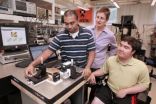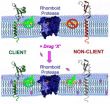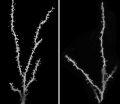(Press-News.org) Researchers at Ludwig-Maximilians-Universitaet (LMU) in Munich have developed a new process which will greatly simplify the process of sorting plastics in recycling plants. The method enables automated identification of polymers, facilitating rapid separation of plastics for re-use.
A team of researchers led by Professor Heinz Langhals of LMU's Department of Chemistry has taken a significant step which promises to markedly expedite the recycling of plastic waste. They have developed a technique which provides for automated recognition of their polymer constituents, thus improving the efficiency of recycling and re-use of the various types of plastic. The technique takes advantage of the polymer-specific nature of the intrinsic fluorescence induced by photoexcitation. "Plastics emit fluorescent light when exposed to a brief flash of light, and the emission decays with time in a distinctive pattern. Thus, their fluorescence lifetimes are highly characteristic for the different types of polymers, and can serve as an identifying fingerprint," Langhals explains. Details of the new method appear in the latest issue of the journal "Green and Sustainable Chemistry".
The new technique, which is the subject of a patent application, involves exposing particles of plastic to a brief flash of light which causes the material to fluoresce. Photoelectric sensors then measure the intensity of the light emitted in response to the inducing photoexcitation to determine the dynamics of its decay. Because the different polymer materials used in the manufacture of plastics display specific fluorescence lifetimes, the form of the decay curve can be used to identify their chemical nature. "With this process, errors in measurement are practically ruled out; for any given material, one will always obtain the same value for the fluorescence half-life, just as in the case of radioactive decay," says Langhals.
Turning bottles into windcheaters
Unlike metals, the quality of which often suffers during the recycling process itself, recycled plastics can be processed quite efficiently. "Polymers represent an interesting basis for the sustainable cycling of technological materials. The crucial requirement is that the recycled material should be chemically pure. In that case, bottles made of PET, for example, can be relatively easily turned into synthetic fiber for use in waterproof windcheaters," says Langhals.
The vast majority of technical polymers are processed as thermoplastics, i.e., they are melted at high temperature and the finished article is produced by injecting the molten material into an appropriate mold, where it allowed to set. Reheating of recycled plastic can, however, lead to deleterious alterations in its properties of the material unless the sorted material is of high purity. Contamination levels as low as 5% are sufficient to significantly reduce the quality of the reformed product. The reason for this "down-cycling" effect is that, as a general rule, polymers tend to be immiscible, as they are chemically incompatible with one another. Remelting of polymer mixtures therefore often leads to partitioning of the different polymers into distinct domains separated by grain boundaries, which compromises the quality of the final product. For this reason, high-quality plastics are always manufactured exclusively from pristine precursors – never from recycled material.
The new method developed by the LMU team could, however, change this. "The waste problem can only be solved by chemical means, and our process can make a significant contribution to environmental protection, because it makes automated sorting feasible," says Langhals. Indeed, the use of fluorescence lifetime measurements permits the identification and sorting of up to 1.5 tons of plastic per hour. In other words, the method in its present form already meets the specifications required for its application on an industrial scale.
INFORMATION: END
Novel recycling methods: The fluorescent fingerprint of plastics
2014-08-21
ELSE PRESS RELEASES FROM THIS DATE:
CHEST releases new expert guidance in care of the critically ill and injured
2014-08-21
The American College of Chest Physicians (CHEST) announces the immediate release of Care of the Critically Ill and Injured During Pandemics and Disasters: CHEST Consensus Statement today in the Online First section of the journal CHEST while the global health-care community cares for patients with the Ebola virus. The consensus statement aims to guide ethical decision-making, coordination of care, resource conservation, and research in crises. The statement was developed by over 100 clinicians and experts representing a broad variety and scope of clinical fields from more ...
Laser device may end pin pricks, improve quality of life for diabetics
2014-08-21
Princeton University researchers have developed a way to use a laser to measure people's blood sugar, and, with more work to shrink the laser system to a portable size, the technique could allow diabetics to check their condition without pricking themselves to draw blood.
"We are working hard to turn engineering solutions into useful tools for people to use in their daily lives," said Claire Gmachl, the Eugene Higgins Professor of Electrical Engineering and the project's senior researcher. "With this work we hope to improve the lives of many diabetes sufferers who depend ...
Objectification in romantic relationships related to sexual pressure and coercion
2014-08-21
To sexually objectify a woman is to focus on her body in terms of how it can provide sexual pleasure rather than viewing her as a complete human being with thoughts and feelings. While objectification has long been considered a problem in the media, how does it affect individual romantic relationships? New research published in Psychology of Women Quarterly, a SAGE journal, finds that more objectification of a female partner's body is related to higher incidents of sexual pressure and coercion.
Researchers Laura R. Ramsey and Tiffany Hoyt surveyed 119 males and 162 females ...
Primary care physicians can be critical resource for abused women in rural areas
2014-08-21
Many primary care physicians in rural communities do not routinely screen women for intimate partner violence (IPV), according to Penn State medical and public health researchers. Rural women who are exposed to such violence have limited resources if they seek help.
"Rural health care providers are uniquely positioned to help women," said Jennifer S. McCall-Hosenfeld, a primary care physician and assistant professor of medicine and public health sciences, Penn State College of Medicine. "However, in rural settings, it might be even more important for physicians to step ...
Viruses take down massive algal blooms, with big implications for climate
2014-08-21
Algae might seem easy to ignore, but they are the ultimate source of all organic matter that marine animals depend upon. Humans are increasingly dependent on algae, too, to suck up climate-warming carbon dioxide from the atmosphere and sink it to the bottom of the ocean. Now, by using a combination of satellite imagery and laboratory experiments, researchers have evidence showing that viruses infecting those algae are driving the life-and-death dynamics of the algae's blooms, even when all else stays essentially the same, and this has important implications for our climate.
According ...
Biologists reprogram skin cells to mimic rare disease
2014-08-21
Johns Hopkins stem cell biologists have found a way to reprogram a patient's skin cells into cells that mimic and display many biological features of a rare genetic disorder called familial dysautonomia. The process requires growing the skin cells in a bath of proteins and chemical additives while turning on a gene to produce neural crest cells, which give rise to several adult cell types. The researchers say their work substantially expedites the creation of neural crest cells from any patient with a neural crest-related disorder, a tool that lets physicians and scientists ...
Sequence of rare kidney cancer reveals unique alterations involving telomerase
2014-08-21
HOUSTON – (Aug. 21, 2014) – An international scientific collaboration led by Baylor College of Medicine has revealed clues about genetic alterations that may contribute to a rare form of kidney cancer, providing new insights not only into this rare cancer but other types as well.
The collaboration, a project of the National Institutes of Health's Cancer Genome Atlas initiative, completed the sequence of chromophobe renal cell carcinoma and published the results today in the journal Cancer Cell.
"The Cancer Genome Atlas is a federally funded national effort that has ...
Some anti-inflammatory drugs affect more than their targets
2014-08-21
Researchers have discovered that three commonly used nonsteroidal anti-inflammatory drugs, or NSAIDs, alter the activity of enzymes within cell membranes. Their finding suggests that, if taken at higher-than-approved doses and/or for long periods of time, these prescription-level NSAIDs and other drugs that affect the membrane may produce wide-ranging and unwanted side effects.
More positively, the researchers say, their work provides the basis for a test that drug developers can use to predict and perhaps avoid these side effects in new medicines they make. A summary ...
Children with autism have extra synapses in brain
2014-08-21
NEW YORK, NY (August 21, 2014) — Children and adolescents with autism have a surplus of synapses in the brain, and this excess is due to a slowdown in a normal brain "pruning" process during development, according to a study by neuroscientists at Columbia University Medical Center (CUMC). Because synapses are the points where neurons connect and communicate with each other, the excessive synapses may have profound effects on how the brain functions. The study was published in the August 21 online issue of the journal Neuron.
A drug that restores normal synaptic pruning ...
Research explains how cellular guardians of the intestine develop
2014-08-21
Even the most careful chosen meal can contain surprises. To defend against infectious microbes, viruses or other potential hazards that find their way to the intestines, a dedicated contingent of immune cells keeps watch within the thin layer of tissue that divides the contents of the gut from the body itself.
New research at Rockefeller University sheds light on the development of a unique class of immune cells known as intraepithelial lymphocytes (IELs) that reside in this critical interface. The findings, published August 21 in Immunity, may help lead to new insights ...




